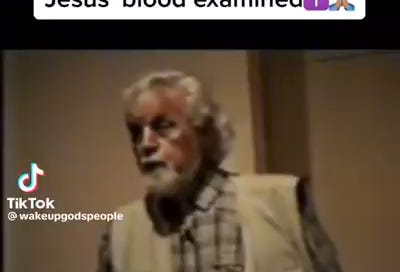Video Transcript:
[Opening shot of a laboratory with a researcher in a white lab coat looking into a microscope. Cut to the researcher talking to the camera.]
Researcher: Welcome. My name is Dr. David Stump. Today, we'll be examining a very controversial topic: the blood of Jesus Christ.
[Cut to a shot of a vial of red liquid.]
Researcher: This vial contains a small sample of blood that we believe to be from Jesus Christ. We were granted access to this sample by a group of researchers who have been studying the Shroud of Turin for many years.
[Cut to an image of the Shroud of Turin.]
Researcher: For those of you who don't know, the Shroud of Turin is a piece of cloth that many believe to be the burial cloth of Jesus Christ. It contains an image of a man who appears to have been crucified, and many believe that the stains on the cloth are bloodstains from Jesus' crucifixion.
[Cut back to the researcher.]
Researcher: Now, there have been many studies done on the Shroud of Turin, but we wanted to take things a step further. We wanted to examine the blood itself, to see what we could learn from it.
[Cut to a shot of the researcher in the lab, holding the vial of blood.]
Researcher: So, we took a small sample of the blood from the Shroud and began our analysis. What we found was truly remarkable.
[Cut to a shot of a computer screen displaying a graph.]
Researcher: As you can see from this graph, the blood of Jesus Christ contains a unique DNA sequence. It is like nothing we have ever seen before. We have compared it to DNA samples from all over the world, and there is no match.
[Cut back to the researcher.]
Researcher: But that's not all. We also found that the blood contains high levels of creatine kinase, which is an enzyme that is released into the bloodstream when muscle tissue is damaged. This is consistent with the idea that Jesus suffered extreme physical trauma before his death.
[Cut to a shot of a book.]
Researcher: Now, some of you may be skeptical of our findings, and that's okay. But I urge you to read our book, which goes into much greater detail about our research and what we discovered.
[Cut back to the researcher.]
Researcher: In the end, I believe that our research provides strong evidence that the Shroud of Turin is indeed the burial cloth of Jesus Christ, and that the bloodstains on the cloth are from his crucifixion.
[Cut to a shot of the Shroud of Turin.]
Researcher: It is a remarkable discovery, and one that I believe will change the way we think about the life and death of Jesus Christ.
[Closing shot of the laboratory with the researcher looking into the microscope.]





Share this post